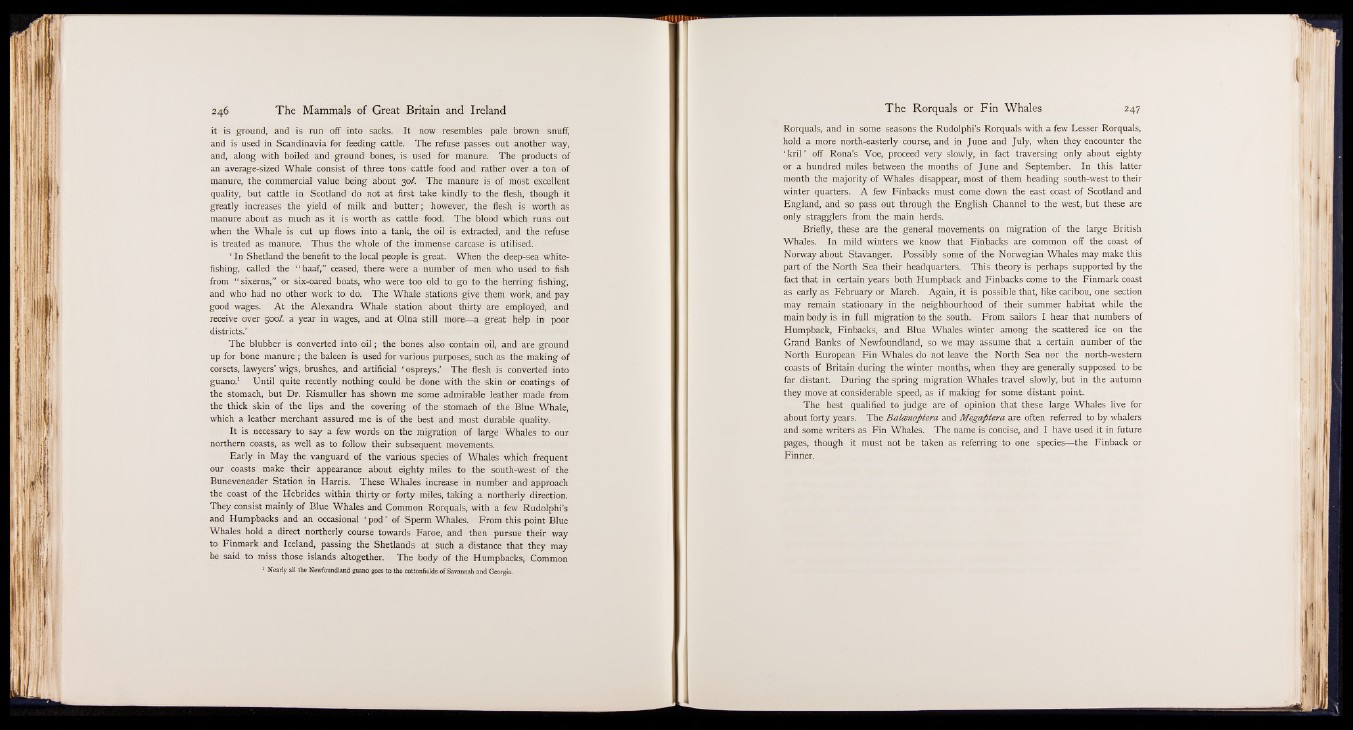
it is ground, and is run off into sacks. It now resembles pale brown snuff,
and is used in Scandinavia for feeding cattle. The refuse passes out another way,
and, along with boiled and ground bones, is used for manure. The products of
an average-sized Whale consist of three tons cattle food and rather over a ton of
manure, the commercial value being about 30/. The manure is of most excellent
quality, but cattle in Scotland do not at first take kindly to the flesh, though it
greatly increases the yield of milk and butter; however, the flesh is worth as
manure about as much as it is worth as cattle food. The blood which runs out
when the Whale is cut up flows into a tank, the oil is extracted, and the refuse
is treated as manure. Thus the whole of the immense carcase is utilised.
| In Shetland the benefit to the local people is great. When the deep-sea whitefishing,
called the “ haaf,” ceased, there were a number of men who used to fish
from “ sixerns,” or six-oared boats, who were too old to go to the herring fishing,
and who had no other work to do. The Whale stations give them work, and pay
good wages. At the Alexandra Whale station about thirty are employed, and
receive over 500/. a year in wages, and at Olna still more— a great help in poor
districts.’
The blubber is converted into o i l; the bones also contain oil, and are ground
up for bone manure ; the baleen is used for various purposes, such as the making of
corsets, lawyers’ wigs, brushes, and artificial ‘ ospreys.’ The flesh is converted into
guano.1 Until quite recently nothing could be done with the skin or coatings of
the stomach, but Dr. Rismuller has shown me some admirable leather made from
the thick skin of the lips and the covering of the stomach of the Blue Whale,
which a leather merchant assured me is of the best and most durable quality.
It is necessary to say a few words on the migration of large Whales to our
northern coasts, as well as to follow their subsequent movements.
Early in May the vanguard of the various species of Whales which frequent
our coasts make their appearance about eighty miles to the south-west of the
Buneveneader Station in Harris. These Whales increase in number and approach
the coast of the Hebrides within thirty or forty miles, taking a northerly direction.
They consist mainly of Blue Whales and Common Rorquals, with a few Rudolphi’s
and Humpbacks and an occasional ‘ pod’ of Sperm Whales. From this point Blue
Whales hold a direct northerly course towards Faroe, and then pursue their way
to Finmark and Iceland, passing the Shetlands at such a distance that they may
be said to miss those islands altogether. The body of the Humpbacks, Common
1 Nearly all the Newfoundland guano goes to the cottonfields of Savannah and Georgia.
Rorquals, and in some seasons the Rudolphi’s Rorquals with a few Lesser Rorquals,
hold a more north-easterly course, and in June and July, when they encounter the
‘ kril’ off Rona’s Voe, proceed very slowly, in fact traversing only about eighty
or a hundred miles between the months of June and September. In this latter
month the majority of Whales disappear, most of them heading south-west to their
winter quarters. A few Finbacks must come down the east coast of Scotland and
England, and so pass out through the English Channel to the west, but these are
only stragglers from the main herds.
Briefly, these are the general movements on migration of the large British
Whales. In mild winters we know that Finbacks are common off the coast of
Norway about Stavanger. Possibly some of the Norwegian Whales may make this
part of the North Sea their headquarters. This theory is perhaps supported by the
fact that in certain years both Humpback and Finbacks come to the Finmark coast
as early as February or March. Again, it is possible that, like caribou, one section
may remain stationary in the neighbourhood of their summer habitat while the
main body is in full migration to the south. From sailors I hear that numbers of
Humpback, Finbacks, and Blue Whales winter among the scattered ice on the
Grand Banks of Newfoundland, so we may assume that a certain number of the
North European Fin Whales do not leave the North Sea nor the north-western
coasts of Britain during the winter months, when they are generally supposed to be
far distant. During the spring migration Whales travel slowly, but in the autumn
they move at considerable speed, as if making for some distant point.
The best qualified to judge are of opinion that these large Whales live for
about forty years. The Balcenoptera and Megaptera are often referred to by whalers
and some writers as Fin Whales. The name is concise, and I have used it in future
pages, though it must not be taken as referring to one species— the Finback or
Finner.